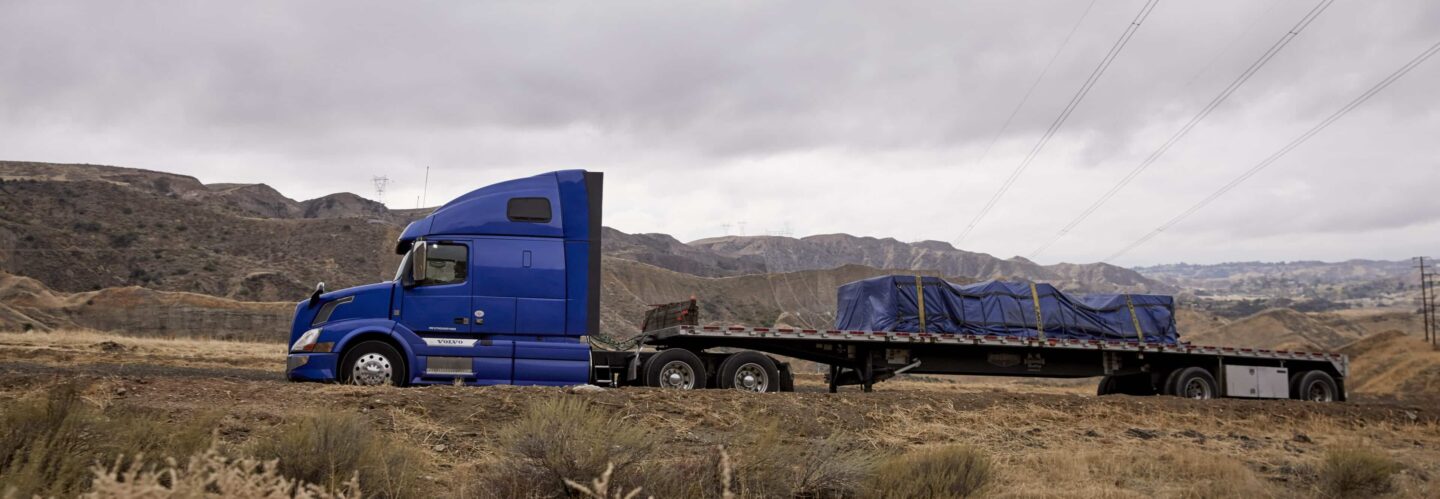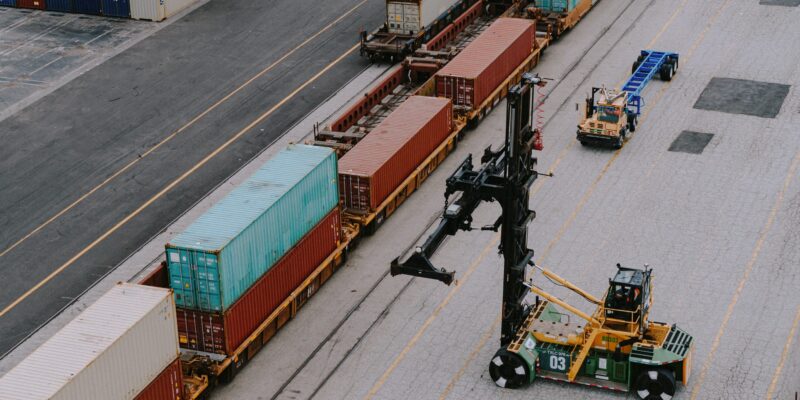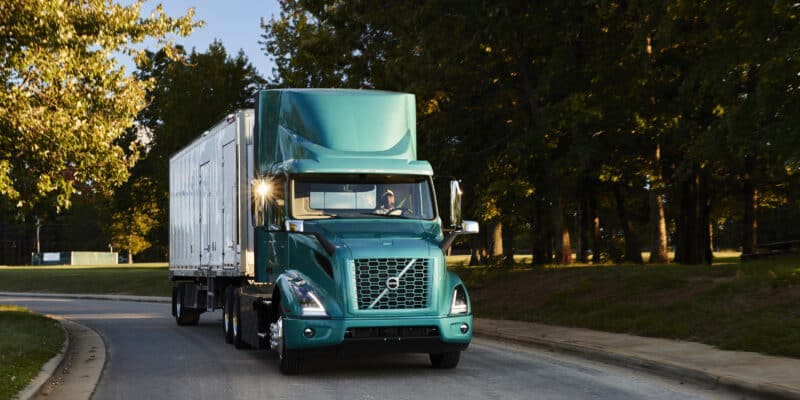The pros & cons of flatbed trucking

Flatbed trucking is becoming the preferred transportation method for many industries when moving large, unusual, or heavy cargo.
The demand for flatbed trucking services is rising due to the growth of the construction, manufacturing, and oil industries. However, as with any transportation method, there are pros and cons to consider when using flatbed trucks.
What is flatbed trucking?
Flatbed trucking is a method of transportation that involves using an open-bed trailer to transport goods. This type of trucking gets its name from the trailer’s flat, level “bed,” which makes loading and unloading goods easier than traditional trailers with enclosed sides.
Flatbed trucking is a popular method of transportation for non-commoditized products and equipment types. These include materials that can be loaded from the side using a crane or forklift and those that are not fragile and can be exposed to the elements during transport. This makes flatbed trucking ideal for transporting raw materials, construction materials, and industrial goods.
Flatbed transport is also highly effective for moving shipping containers. These trucks transport containers from inland ports or factories to seaports, where they get loaded onto ships. Flatbed trailers are capable of transporting super sacks and industrial fabric bags holding up to 2,000 pounds of dry products like sand, fertilizer, or seeds.
When to use flatbed trucking
Flatbed trucking is particularly suited for transporting oversized or irregularly shaped items that do not fit within the constraints of standard enclosed trailers. This mode allows for easy access during loading and unloading—cranes and forklifts can freely operate around the cargo, significantly reducing labor costs and expediting the process. However, the open nature of flatbeds exposes goods to environmental factors, thus requiring robust protective measures like tarps and secure strapping to shield against weather-related damages.
For example, consider a scenario where large construction beams need to be transported from a manufacturing site to a building project across the state. Flatbed trucking would facilitate the direct loading and unloading of these beams, streamlining the process significantly. Strategic route planning would also come into play to avoid low bridges or heavy-weight restrictions, optimizing fuel consumption despite the flatbed’s vulnerability to wind resistance.
Pros & cons of flatbed trucking
Flatbed trucking has its own set of advantages and disadvantages, which we will discuss below.
Pros
There are several advantages of using flatbed trucking as a transportation method:
- The versatility, capacity, and accessibility of flatbed trailers make them a preferred choice for full truckload (FTL) shipping, particularly when transporting large, heavy, or irregularly shaped cargo that do not fit in standard trailers.
- With no sides or roof, flatbed trailers offer easy access to the cargo, making it easier and faster to load and unload goods. This saves time and reduces the risk of damage during loading and unloading.
- Flatbed trailers are built to withstand heavy loads and harsh road conditions. This makes them a reliable option for transporting goods that are susceptible to damage from vibration or impact.
- Despite being traditionally favored for large or irregular loads, flatbed trucking also offers remarkable flexibility for transporting LTL shipments alongside other cargo.
Cons
Flatbed freight planning often can be complicated, fragmented, and time-consuming. This is largely due to flatbed loads’ varying sizes, dimensions, and weight. Other potential disadvantages include:
- Unlike enclosed trailers, flatbed trailers do not offer protection from weather conditions. This makes them unsuitable for transporting goods that are sensitive to moisture or extreme temperatures.
- While flatbed trucks offer easy access to cargo, loading and securing large or oddly shaped items can be challenging. This requires specialized equipment and expertise, which may increase the overall cost of transportation.
- Due to the trailer’s open design, flatbed truck driving can be more challenging and requires skilled drivers. Maneuvering on highways or through tight spaces can be difficult, making it a potentially risky transportation option.
Managing broad carrier compliance and networks as a shipper can be risky – Uber Freight holds the largest long-tail network in the nation. With thousands of real-time data points, Uber Freight has the most accurate flatbed pricing index for both spot and contractual needs.
Types of flatbed truck trailers

Flatbed trailers typically span from 48 to 53 feet in length, with a standard width of around 8.5 feet. These trailers can generally transport cargo weighing up to about 48,000 pounds. Remember, these are rough estimates; the actual dimensions and capacities may vary based on the specific trailer design.
- Standard Flatbed Trailer: This is the most commonly used type of flatbed trailer, featuring a simple and straightforward design with a flat loading area and no sides or roof.
- Step Deck Trailer or Drop Deck Trailer: Drop decks have two upper and lower deck levels to accommodate taller loads that do not exceed the maximum legal height.
- Extendable Flatbed Trailer: As the name suggests, these trailers can be extended in length to accommodate unusually long or oversized cargo.
- Conestoga Trailer: This type of flatbed trailer has a retractable tarp system, providing protection similar to an enclosed trailer. It is ideal for transporting goods that are sensitive to weather conditions.
- Lowboy Trailer (Double Drop Deck): These trailers have a lower deck height, making them suitable for hauling taller items such as heavy machinery.
- Removable Gooseneck (RGN) Trailer: These trailers have a detachable front end, allowing for easy loading and unloading of heavy equipment.
- Hot Shot Trailer: Short trailers that can be hauled by Class 2 pickup trucks. These trailers are usually 20’-40’ and run at a lower cost per mile than standard flatbed trailers.
Flatbed shipping tips
Here are some tips for shippers to ensure a smooth and successful shipping experience when shipping with flatbed equipment:
- Optimize load planning, focusing on maximizing space and ensuring safety. Consider cargo dimensions and weight distribution to prevent overloading and ensure compliance with road safety regulations.
- Establish and maintain strong relationships with a network of reliable carriers. This can lead to more favorable rates, better service levels, and access to capacity during peak times.
- Ensure flatbed truck drivers are following safety protocols and best practices for securing and transporting loads. This is crucial to prevent accidents and ensure cargo’s and others’ safety on the road.
- Use analytics to gain insights into shipping operations. Analyzing data on shipping patterns, carrier performance, and costs can help identify areas for improvement and inform strategic decisions.
Shipping flatbed with Uber Freight
Ready to take advantage of a robust network that simplifies your flatbed shipping needs? With Uber Freight’s extensive carrier base of over 500 flatbed providers, dedicated truck management for account-specific needs, and capabilities for oversized loads, we’ve got your freight covered. Harness our $500M+ network volume and experience the ease of project management and job site delivery.
Our specialized flatbed solutions include arranging:
- Heavy Haul Services: For loads exceeding 46,000 pounds, with a total combined weight capacity of up to 80,000 pounds for truck and trailer.
- Specialized Freight Needs: Catering to shipments that require custom critical equipment, enhanced insurance protections, and third-party clearances, perfect for high-value and super loads.
- Over-Dimensional Freight: Expert handling of goods that exceed the standard dimensions for regular flatbed transportation
- Hot Shot Deliveries: Fast, efficient service for urgent shipments
From initial project quotations and carrier selection to detailed pre-planning, execution, and post-delivery debriefing, our thorough process ensures meticulous management of your shipment every step of the way. Elevate your flatbed trucking experience with Uber Freight’s robust solutions and connect with an expert today to move your freight with confidence.
Shippers can also sign up on Uber Frieght’s Freight Shipping Services online booking platform to get an instant quote and book a 48’ flatbed load today.



